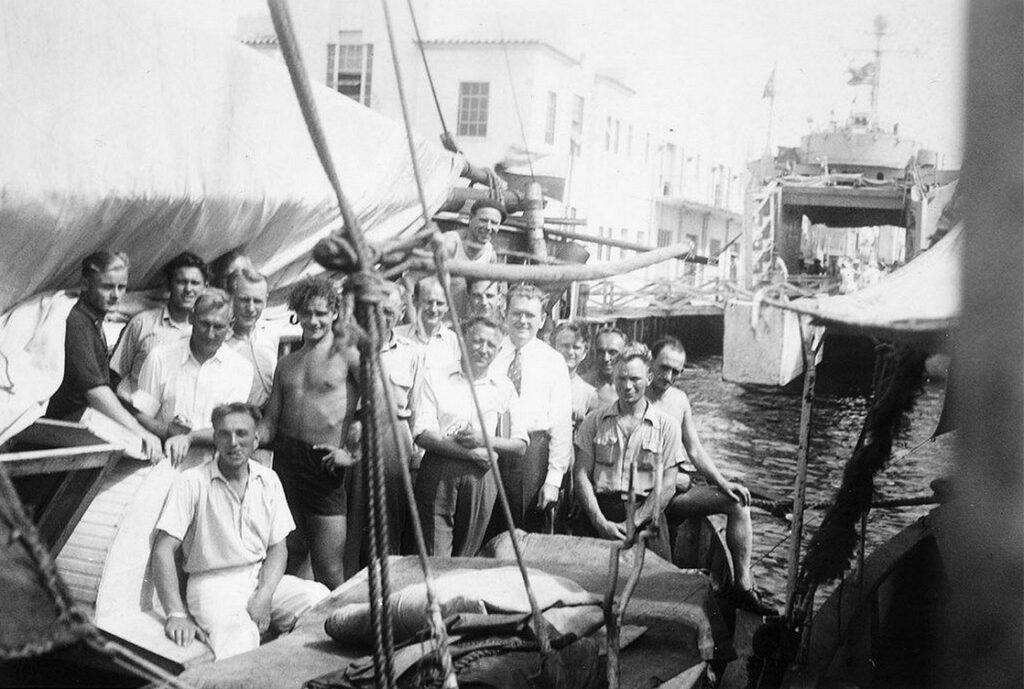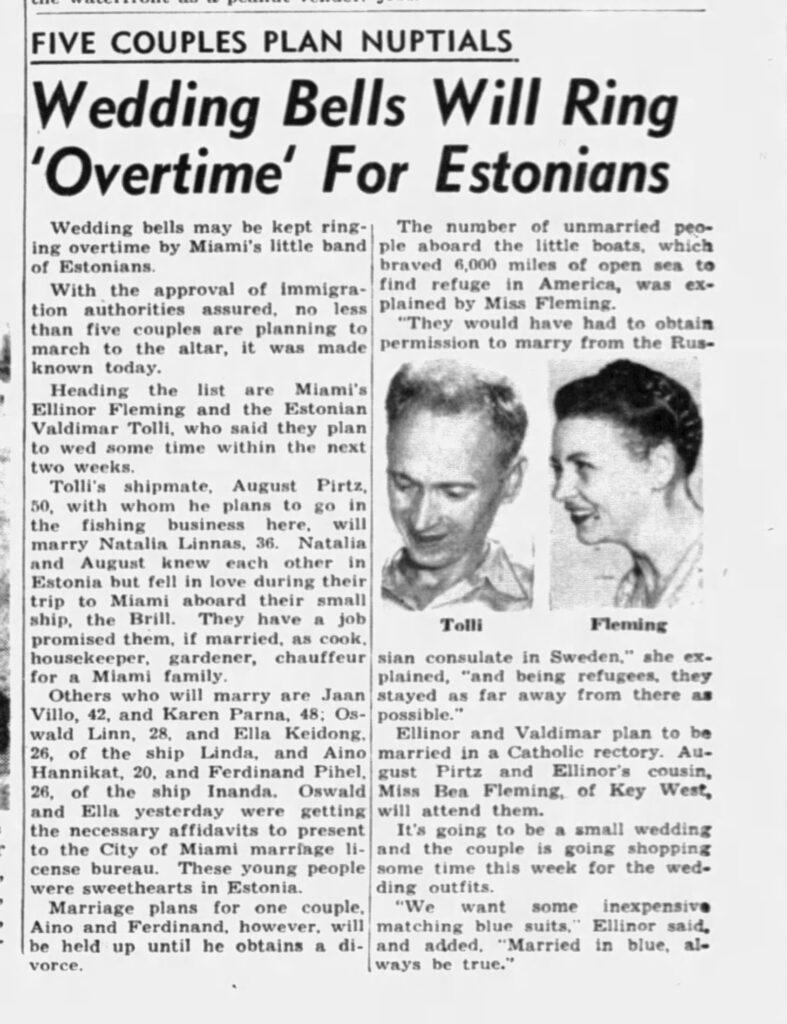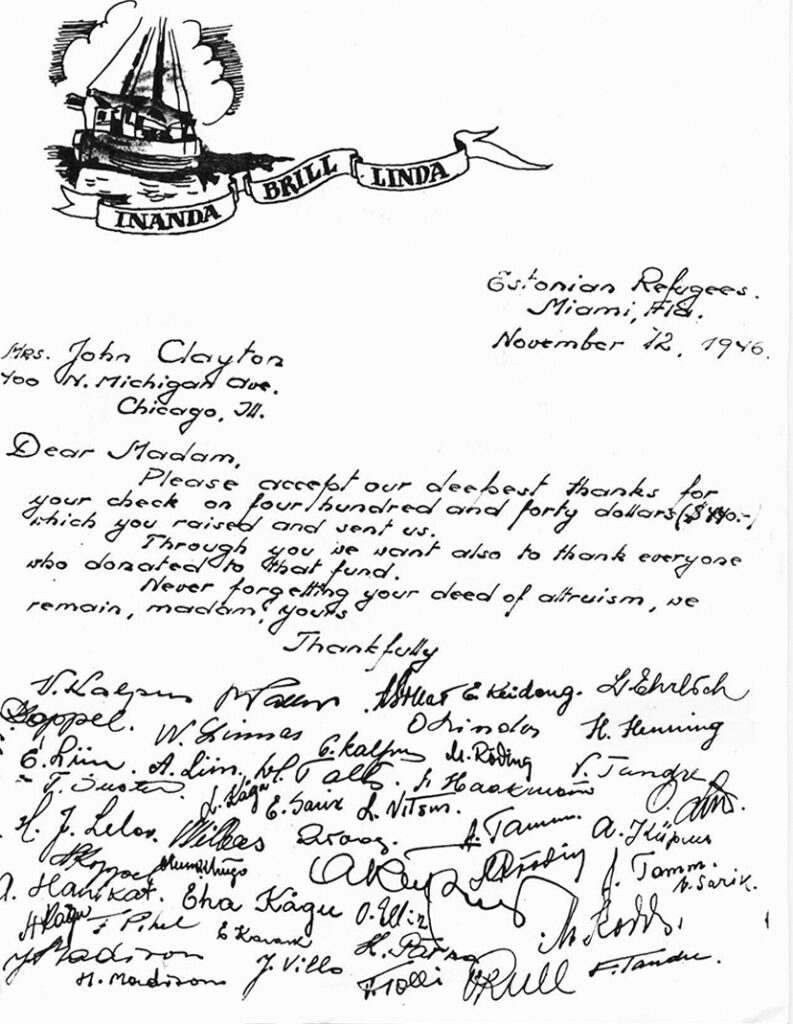Boats

Passagerare ombord Linda i Miami, med estniska generalkonsulen Ernst Jaakson i mitten, iklädd slips. Jaaksons diplomatkarriär påbörjades i ett självständigt Estland. Han fortsatte att representera sitt hemlands diplomatiska intressen utomlands genom den långa sovjetiska ockupationen, och blev Estlands ambassadör till USA efter självständigheten återvanns 1991.
LINDA
Linda, under befäl av kapten Valter Rull, kom fram till Miami 20 september 1946 med 18 estniska flyktingar ombord efter en resa på 83 dagar. En man ombord hade brutit ryggen under en storm i Biscayabukten men “kände sig okej” när han nådde Miami, enligt en artikel i New York Times.
Flyktingarnas mottagande i Amerika
Ingen av flyktingarna ombord varken Inanda, Brill eller Linda hade amerikanskt visum, men de blev trots det inte deporterade omedelbart. Istället blev de tillsagda att ifall deras ansökningar avvisades skulle de få tid att göra de fallfärdiga båtarna sjövärdiga innan fortsatt resa. Till svar sa flyktingarna att de inte hade någon annanstans att ta vägen, och hellre skulle drunkna till sjöss.

Fem par från de tre båtarna gifte sig strax efter ankomst till Amerika. Valdimar Tolli träffade amerikanska Ellinor Fleming, en sekreterare, efter att han anlänt ombord Brill. De andra paren var ester som inte ville gifta sig i Sverige eftersom det krävde tillåtelse från det sovjetiska konsulatet i Stockholm. Miami News, 20 november 1946.
“Jag vill ha fred, ett hem och barn,” meddelade Osvald Linn som kommit till USA ombord båten Linda. “Jag har levt sex år utan ett hem, utan tillräckligt med mat, och utan frid i sinnet. Jag står inte ut längre.”
Eftersom båtarna hade anlänt ungefär samtidigt behandlade myndigheterna de 48 esterna som en och samma grupp. Med hjälp av en lokal katolsk präst, James Loeffler, samt en luthersk präst, William C. Wahl, skrev flyktingarna ett flertal petitioner, inklusive till president Harry S. Truman.
Efter att nyhetstidningar hade rapporterat om de svåra och långa båtresorna växte även offentligt stöd för flyktingarna. Den 25 oktober 1946 publicerade New York Times en ledarsida där de bad Amerika att släppa in “dessa robusta, fyndiga människor som har trotsat stormiga havsresor i små båtar för att de drömde om ett Amerika som en säker och vänlig tillflyktsort där var man är fri.”
I december 1946, beslutade USA:s högsta domstol att flyktingarna skulle få stanna i USA. För att kunna få amerikanska visum var flyktingarna dock tvungna att flyga till Bahamas för att få officiella dokument så de skulle kunna ansöka om amerikanskt medborgarskap efter fem år.

Tackbrev från passagerarna ombord de tre båtarna för ett finansiellt bidrag de mottog.
Efter att de hade fått tillåtelse att stanna, skapade flyktingarna tre läderbundna album med bilder från ett självständigt Estland, deras flykt till Sverige och livet som flyktingar, samt deras resa över Atlanten. Fotoalbumen presenterades för president Truman, kung Gustav V av Sverige och James Leuffner, den katolska prästen i Miami. Fotoalbumet som gavs till den svenska kungen är bevarat hos Bernadottebiblioteket i Stockholm.
Kända besättningsmedlemmar och passagerare:
- Kapten Valter Rull
- Mikhael Koddu
- Karin Pärna
- Jaan Tamm
- Voldemar Talts
- Bröderna Osvald, Alfred och Erni Liin
- Linda Ehrlich-Liin
- Ella Keidong
- Heinard Henning
- Jaan Tamm
- Jaan Villo
- Helmar och Maria Rooding
- Teo Suster och Esther Karask-Suster
- Aleks Haakman
- Otto Ellik
Fotografier använda med tillåtelse från Estniska sjöfartsmuseet.
